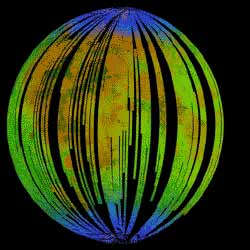NASA, ISRO confirm the presence of water on the moon
25 Sep 2009
ISRO and NASA scientists have confirmed that widespread water has been detected on the surface of the moon and that the chemistry of the moon is indeed different than what has been surmised for decades. It is now clear that the interaction of the solar wind with rocky bodies without an atmosphere is a phenomenon yet to be fully investigated.
 |
| Caption: Small amounts of water and hydroxyl (blue) were detected on the surface of the moon at various locations. This image illustrates their distribution at high latitudes toward the poles. Image credit: ISRO/NASA/JPL-Caltech/Brown Univ./USGS |
NASA's M3 was carried onboard the Indian lunar orbiter Chandrayaan-1, which terminated its mission prematurely but with a huge success quotient, in terms of mission objectives achieved.
The attention of the space scientific community has now turned towards pondering how this discovery, arguably the most significant in space exploration for decades, is going to impact the future of space activity.
Space scientists now point out that the presence of so much water would make living on the moon much easier as it would be used not only for drinking but also for conversion into oxygen for breathing purposes and splitting into hydrogen and oxygen for use as a rocket propellant.
The new discovery is significant in that data indicates that water molecules form and dissipate across broader areas, even in lunar daylight. This overhauls earlier assumptions that water was probably available only in the form of water ice formed from comet impacts and lying in cold, permanently shadowed craters near the moon's poles.






















